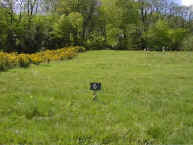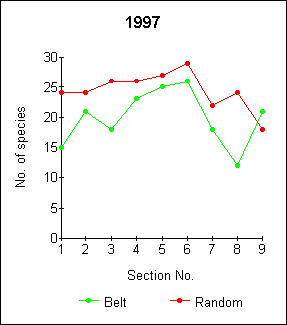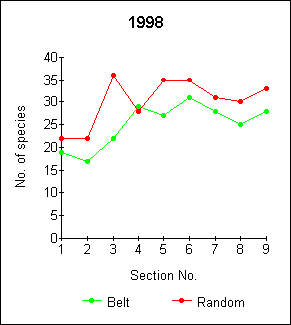|
The
Woodland Education Centre |
|
|
The
Woodland Education Centre |
|
The Effects of Management -
Frequency of Brush cutting

Section 6
| Cutting, whenever it takes place, will have the effect of reducing
competition for light and space for a time. This may allow species to establish which
would not otherwise be able to compete with the dominant plants. The more frequent the cutting, the more this effect is likely to be exaggerated. This is illustrated by the fact that Section 6, which is cut three times a year, had the highest species diversity on the project site. It was also the only area where annual plants became established. The frequency of cutting had not discouraged Yorkshire Fog, which was still the dominant species in this section (Table), but it did allow more species to become established. Annual plants obviously require space to be available in order to colonize an area. All plants found on the project site were perennials apart from Common Centaury (Centaurium erythraea), which is an annual. It is significant that section 6 was the only section where this species occurred. The percentage cover of Polytrichum, which carpets areas between other higher plants, was also highest in section 6 in 1998 (Chart). |
 |
 |
Species Diversity in 1997 |
Species Diversity in 1998 |
| Species diversity figures for 1997 showed that section
6 had the highest species diversity of all the sections on the site (Figures above) The
trend was similar in 1998, although by this time, species diversity had reached a similar
level in the control section, section 5, and in section 3, which is brushcut in the
autumn. Species diversity was high in the control section (5) in 1998 because the grasses were prevented from becoming dominant by the gorse height (up to 2m) in this section. As a consequence of the frequent cutting in section 6, Heather plants growing in this section had a quite different growth form. They formed very low dense clumps, excluding other species because of the density of growth. As a result, Heather may come to dominate in this section in time, because it is likely to outcompete other species through the impenetrability of its canopy. |
Continue to the effects of grass control
Ecological Surveys 96 - 98 |